Previous Year Questions- Operational Amplifiers - 3 | Analog and Digital Electronics - Electrical Engineering (EE) PDF Download
Q31: An ideal op-amp circuit and its input wave form as shown in the figures. The output waveform of this circuit will be (2009) (a)
(a) 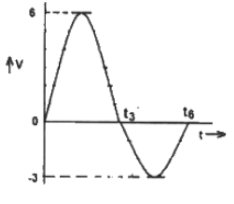 (b)
(b)  (c)
(c)  (d)
(d)  Ans: (d)
Ans: (d)
Sol:  When Vi < V1(upto t2); Vo = +ve
When Vi < V1(upto t2); Vo = +ve
When Vi > V1(t2 ≤ t ≤ t4); Vo = −ve
Q32: Transformer and emitter follower can both be used for impedance matching at the output of an audio amplifier. The basic relationship between the input power Pin and output power Pout in both the cases is (2009)
(a) Pin = Pout for both transformer and emitter follower
(b) Pin > Pout for both transformer and emitter follower
(c) Pin < Pout for transformer and Pin = Pout for emitter follower
(d) Pin = Pout for transformer and Pin < Pout for emitter follower
Ans: (d)
Sol: For emitter follower
AV ≅ 1; AI is high
⇒ AP = AV⋅AI is high ⇒ Pout > Pin
For transformer, Pin = Pout
Q33: The following circuit has R = 10kΩ, C = 10μF. The input voltage is a sinusoidal at 50 Hz with an rms value of 10 V. Under ideal conditions, the current is from the source is (2009) (a) 10π mA leading by 90%
(a) 10π mA leading by 90%
(b) 20π mA leading by 90%
(c) 10 mA leading by 90%
(d) 10π mA lagging by 90%
Ans: (d)
Sol:  Is = −VsjωC
Is = −VsjωC
= −j(10 × 2π × 50 × 10 × 10−6)
= −j10π...mA
= 10π mA lagging by 90°
Q34: The nature of feedback in the op-amp circuit shown is (2009) (a) Current-Current feedback
(a) Current-Current feedback
(b) Voltage-Voltage feedback
(c) Current-Voltage feedback
(d) Voltage-Current feedback
Ans: (b)
Sol: Voltage-series feedback arrangement or voltage-voltage feedback.
Q35:A general filter circuit is shown in the figure : The output of the above circuit is given to the circuit shown below in figure :
The output of the above circuit is given to the circuit shown below in figure : The gain v/s frequency characteristic of the output (vo) will be (2008)
The gain v/s frequency characteristic of the output (vo) will be (2008)
(a)  (b)
(b)  (c)
(c)  (d)
(d)  Ans: (d)
Ans: (d)
Sol:  Which is similar to equation of a band pass filter.
Which is similar to equation of a band pass filter.
Q36: A general filter circuit is shown in the figure : If R1 = R2 = RA and R3 = R4 = RB, the circuit acts as a (2008)
If R1 = R2 = RA and R3 = R4 = RB, the circuit acts as a (2008)
(a) all pass filter
(b) band pass filter
(c) high pass filter
(d) low pass filter
Ans: (c)
Sol:  Let, Vi only on onverting terminal
Let, Vi only on onverting terminal Here,
Here, 
Let, Vi only only on non-inverting terminal
 Putting the value of Rf, we get
Putting the value of Rf, we get So, it is high pass filter.
So, it is high pass filter.Q37: A waveform generator circuit using OPAMPs is shown in the figure. It produces a triangular wave at point 'P' with a peak to peak voltage of 5 V for vi = 0V.
 If the voltage vi is made +2.5 V, the voltage waveform at point 'P' will become (2008)
If the voltage vi is made +2.5 V, the voltage waveform at point 'P' will become (2008)(a)
 (b)
(b) 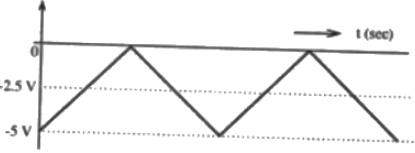 (c)
(c)  (d)
(d)  Ans: (a)
Ans: (a)Q38: The block diagrams of two of half wave rectifiers are shown in the figure. The transfer characteristics of the rectifiers are also shown within the block.
 It is desired to make full wave rectifier using above two half-wave rectifiers. The resultants circuit will be (2008)
It is desired to make full wave rectifier using above two half-wave rectifiers. The resultants circuit will be (2008)(a)
 (b)
(b)  (c)
(c)  (d)
(d)  Ans: (b)
Ans: (b)Sol: For (Vin > 0),
P → V01 = negative
Q → V02 = 0
 V0 will be positive due to inverting action.
V0 will be positive due to inverting action.For (Vin < 0),
P → V′01 = 0
Q → V′02 = positive
V0 will be positive due to non-inverting action. So, output is always rectified.
Q39: The switch S in the circuit of the figure is initially closed, it is opened at time t = 0. You may neglect the zener diode forward voltage drops. What is the behavior of Vout for t > 0? (2007)
 (a) It makes a transition from -5 V to +5 V at t = 12.98 μs
(a) It makes a transition from -5 V to +5 V at t = 12.98 μs(b) It makes a transition from -5 V to +5 V at t = 2.57 μs
(c) It makes a transition from +5 V to -5 V at t = 12.98 μs
(d) It makes a transition from +5 V to -5 V at t = 2.57 μs
Ans: (c)
Sol: Let the voltage at the non-inverting terminal of the opamp be Va volts and the voltage at inverting terminal be Vb volts.
At t = 0+ switch is open Vo = 5V and Vb = −10V
 As t → ∞, Vb → 10 V
As t → ∞, Vb → 10 VVb = Vf+(Vi−Vf)e−t/RC....(i)
Putiing , Vb = (50/11) at t = T1
Vi = −10V and Vf = 10V in eq.(i)
We get, T1 = 12.98 μsec
∴ At t = 12.98μsec, Vo changes from 5V to -5V.
Q40: The circuit shown in the figure is (2007)
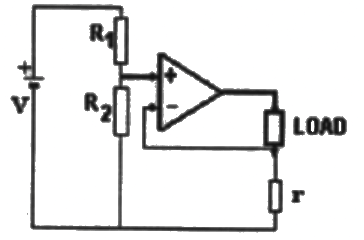 (a) a voltage source with voltage
(a) a voltage source with voltage 
(b) a voltage source with voltage 
(c) a current source with current 
(d) a current source with current 
Ans: (d)
Sol: It behaves as current source because the output current Io depends upon (Vin) and resistance only.
Where, 
Q41: A relaxation oscillator is made using OPAMP as shown in figure. The supply voltages of the OPAMP are ±12 V. The voltage waveform at point P will be (2006) (a)
(a)  (b)
(b)  (c)
(c)  (d)
(d)  Ans: (a)
Ans: (a)
Sol: Output will be either at +Vsat or −Vsat. When output will be at +Vsat diodde connected to 10kΩ resistance will be on making voltage at point P equal to 6V.
When output will be at −Vsat diodde connected to 2kΩ resistance will be on making voltage at point P equal to -10V.
Q42: For a given sinusoidal input voltage, the voltage waveform at point P of the clamper circuit shown in figure will be (2006)
 (a)
(a) 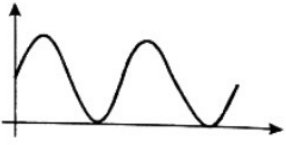 (b)
(b)  (c)
(c)  (d)
(d)  Ans: (d)
Ans: (d)Sol: For -ve half of the input +ve terminal of OPAMP is at higher potential than -ve terminal and output goes to +Vsat but due to this high potential diode gets on and restricts the output to 0.7V only.
And for +ve half of the input +ve terminal of OPAMP is at lower potential than -ve terminal's potential and output goes to −Vsat and remains at −Vsat.
Q43: In the given figure, if the input is a sinusoidal signal, the output will appear as shown (2005)
 (a)
(a)  (b)
(b)  (c)
(c)  (d)
(d)  Ans: (c)
Ans: (c)Sol: Output will be at its saturation values and it is having a phase difference of (180°).
For +ve half of the input, first diode will be on making -ve terminal of op-amp to 0.7V larger than the voltage at +ve input, so output will be −Vsat.
For -ve half of the input reverse of the above will happen and output will go +Vsat.
Q44: Consider the inverting amplifier, using an ideal operational amplifier shown in the figure. The designer wishes to realize the input resistance seen by the smallsignal source to be as large as possible, while keeping the voltage gain between -10 and -25. The upper limit on RF is 1 MΩ. The value of R1 should be (2005)
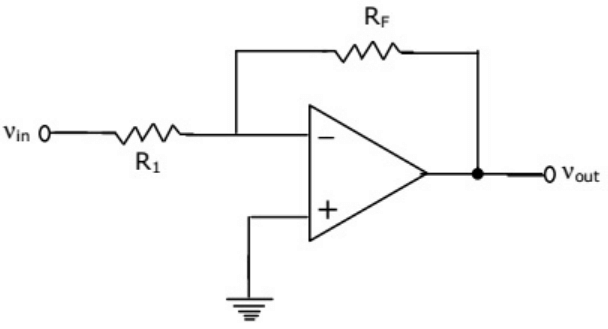 (a) Infinity
(a) Infinity(b) 1MΩ
(c) 100kΩ
(d) 40kΩ
Ans: (d)
Sol:
 If gain = -25 then
If gain = -25 then 
If gain = -10 then 
So if we keep R1 to be 100kΩ then we never get the gain -25 for any RF so we can keep R1 to be 40kΩ.
Q45: The input resistance
 of the circuit in figure is (2004)
of the circuit in figure is (2004)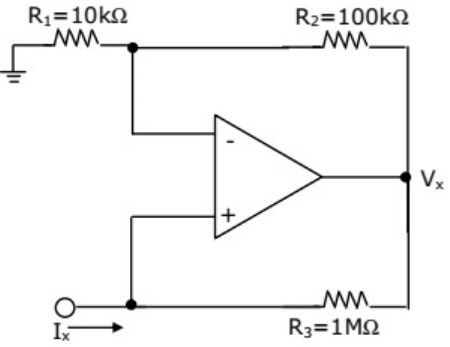 (a) +100kΩ
(a) +100kΩ(b) −100kΩ
(c) +1MΩ
(d) −1MΩ
Ans: (b)
Sol:
 Here,
Here, 
But, 

 (a) -1
(a) -1(b) -20
(c) -100
(d) -120
Ans: (d)
Sol: Using KCL at node 1, we have,

 12V1 = Vout ...(i)
12V1 = Vout ...(i)Also, using KCL at inverting node, we get
 V1 = −Vin × 10 ...(ii)
V1 = −Vin × 10 ...(ii) From equation (i) and (ii), we get

Q47: For the circuit of figure with an ideal operational amplifier, the maximum phase shift of the output Vout with reference to the input Vin is (2003)
 (a) 0°
(a) 0°(b) -90°
(c) +90°
(d) ±180°
Ans: (d)
Sol:
 where, V(−) = V(+) [For ideal Op-amp]
where, V(−) = V(+) [For ideal Op-amp] For −90° ≤ θ ≤ 90°, maximum phase shift occurs (+180°).
For −90° ≤ θ ≤ 90°, maximum phase shift occurs (+180°). Q48: An op-amp, having a slew rate of 62.8 V/μsec, is connected in a voltage follower configuration. If the maximum amplitude of the input sinusoid is 10V, then the minimum frequency at which the slew rate limited distortion would set in at the output is (2001)
(a) 1 MHz
(b) 6.28 MHz
(c) 10 MHz
(d) 62.8 MHz
Ans: (a)
Sol: S.R. = ωVm
62.8V/μs = 2πf × 10

|
137 videos|144 docs|71 tests
|
FAQs on Previous Year Questions- Operational Amplifiers - 3 - Analog and Digital Electronics - Electrical Engineering (EE)
| 1. What is an operational amplifier (op-amp) and how does it work? |  |
| 2. What are the different configurations in which an op-amp can be used? |  |
| 3. What are the ideal characteristics of an op-amp? |  |
| 4. How can negative feedback be used in op-amp circuits? |  |
| 5. What is the significance of the slew rate in op-amps? |  |
















